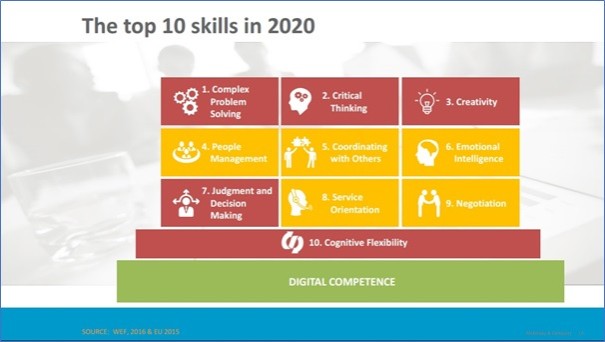Learning as a success factor
 vrijdag 16 juni 2017
vrijdag 16 juni 2017 How to keep up our employees in this age of rapid IT-developments and digitalization? How to guarantee employability? What to expect from our employees and what is the employers’ responsibility? This theme session ‘The Learning Organization’ was initiated by CC Labour Market & Education to explore all kind of such issues.
René Steenvoorden, Global Chief Digital Officer of Randstad hosted this theme session last Tuesday June the 15th. After a short introduction of all attendees, it turned out there is an urgent need to share knowledge to keep employees’ skills and competences aligned to the continuously changes due to digitalization. The speakers provided us with their theoretical insights, while the participants of the session underlined the urge of the problem with their practical examples.
René Steenvoorden presented the impact of digitalization regarding the recruitment and selection process within Randstad. It’s hard to find suitable candidates because of the growing scarcity on the labour market for IT employess. By using technology, it is possible to apply a more personal touch to approach candidates. Besides that, technology can enrich their personal profiles with new data. However, every individual country needs a different approach due to legislation and culture.
All changes in our society, dictated by digitalization and affected by concerns about our climate, the sense of urgency about the need to change and also the willing to change is growing. The most important competence needed to accomplish this, is learning! Robert-Jan Simons (Director ‘Visie op Leren’, emerity professor Utrecht University) showed us how to make this happen from the perspective of his Vision on Learning. Accompanied by several examples he outlined how the mindset and mind shift of people work. The concept of learning within an organization usually is arranged by traditional guidelines. His vision on learning describes continuously learning for everybody. Upon appointment an employer should challenge and energize a new employee to always keep his or her drive to learn. This will encourage employees to keep on learning during their employment and to keep up with all the changes. This will prevent the uncomfortable situation for organizations to have employees who don’t learn (and vary and grow) and at the end not able are to face all the changes.
Implicit learning is a theory to apply in daily practice. By arranging essential experiences and tempting the employees to attend those experiences. In small steps the process of learning comes to a higher level. It’s important to reflect the learning experience afterwards with an inspirational expert. Avoid phrasing targets before starting the learning process. But point out afterwards that you’ve learned to do (or not do) something in a certain manner. Examples to apply this kind of learning are: problem solving, decision making, advising, designing, researching, working together, etc.
The third speaker, Jan Rijken (Director, Crossknowledge Learning Institute) introduced several researches and publications about "Are you ready for the digital future". All jobs of the near future have a strong focus on IT. Unfortunately the necessarily skills needed aren’t available. About 40% of all EU employees has a lack of digital skills and 14% doesn’t have any experience at all. Examples of digital skills are shown in the chart below.

The importance of implementing a Learning Department within the organization will grow and can be used to recruit high potentials and ambitious candidates. Appealing assets could be the presence of a Business School and a Chief Learning Officer within your company. Jan Rijken highlighted the components of the strategy which fits in such a learning environment. ‘Practise what you preach’ is very important and a basic asset within Learning Leadership. Be aware it’s all about the person and not about the technology. To make this happen it is necessary for the CIO, HR and the L&D Officer to work closely together.
Some takeaway’s of this Theme Session – The Learning Organization:
- Invite candidates during the selection process to be creative, for example: make a short movie about themselves and how they would shape the job they are applying for.
- Add digitalization to your recruitment and selection process. There are numerous possibilities to apply.
- Say goodbye to long term plans about learning. Emphasize learning itself, and make Implicit Learning leading.
- Think about appointing a Chief Learning Offer, a Business School, an internal Academy or a learning community.
- Just in time, just enough – take small steps at a time.
- Get rid of the traditional ideas about difference in salary of a manager and an employee. Everyone has their own talents and qualities.
- Match a junior with a senior employee, to be inspired in both directions and open up for change necessary to work successfully together.
- Make sure you have a good branding strategy to promote your Academy/Business School for recruiting.
- Establish a digital competence framework for your organization.
- Discuss with your employees how they see their own development and responsibility in learning.
